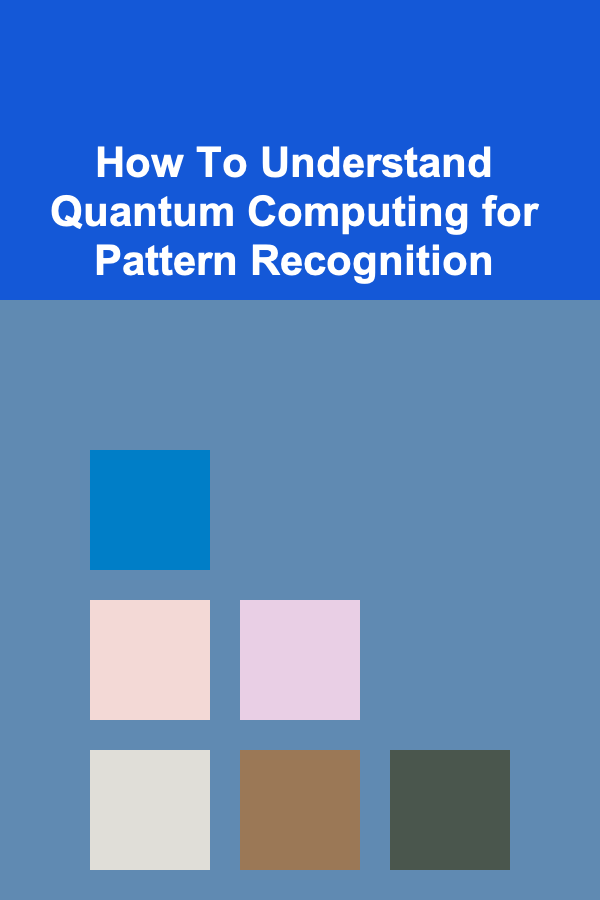
How To Understand Quantum Computing for Pattern Recognition
ebook include PDF & Audio bundle (Micro Guide)
$12.99$5.99
Limited Time Offer! Order within the next:

Quantum computing has become one of the most groundbreaking developments in modern computing, promising to revolutionize various fields ranging from cryptography to artificial intelligence. One of the most exciting and transformative applications of quantum computing is its potential in pattern recognition. Pattern recognition, which plays a pivotal role in machine learning, data analysis, and artificial intelligence, involves identifying patterns and regularities in data. With the advent of quantum computing, researchers have begun to explore how quantum systems can outperform classical computing techniques in tasks involving large, complex datasets.
This article aims to provide a deep dive into the relationship between quantum computing and pattern recognition, with a focus on how quantum mechanics can enhance the capabilities of pattern recognition systems. We will cover the fundamentals of quantum computing, the principles of pattern recognition, and how quantum computing can be leveraged to solve pattern recognition problems more efficiently and accurately than classical computing methods.
The Fundamentals of Quantum Computing
Before delving into the specifics of how quantum computing applies to pattern recognition, it is essential to understand the basic principles of quantum computing. Quantum computing operates based on the principles of quantum mechanics, a branch of physics that explains the behavior of matter and energy at the smallest scales---atoms and subatomic particles.
Qubits: The Quantum Analog of Bits
Classical computing uses binary bits to store and process information, where each bit is either a 0 or a 1. Quantum computing, however, uses quantum bits or qubits. Qubits differ from classical bits in two fundamental ways:
- Superposition: A qubit can exist in multiple states simultaneously. Unlike a classical bit, which can only be in one of two states (0 or 1) at any given time, a qubit can be in a state that is a linear combination of both 0 and 1. This property allows quantum computers to process a vast amount of information in parallel, exponentially increasing their computational power for certain tasks.
- Entanglement: When two qubits are entangled, their states are linked in such a way that the state of one qubit can instantaneously affect the state of the other, no matter how far apart they are. Entanglement is crucial for quantum algorithms and enables quantum computers to perform complex operations that are difficult for classical systems to replicate.
Quantum Gates and Quantum Algorithms
In classical computing, operations on bits are performed using logical gates such as AND, OR, and NOT. Quantum computing uses quantum gates, which manipulate qubits through unitary operations. These quantum gates can perform operations such as rotating the qubit's state or entangling two qubits.
Quantum algorithms leverage these operations to solve problems. Some of the most well-known quantum algorithms include Shor's Algorithm (for factoring large numbers) and Grover's Algorithm (for searching unsorted databases), both of which offer significant speedups compared to classical algorithms.
For pattern recognition, quantum computing can potentially offer a paradigm shift by leveraging quantum properties such as superposition and entanglement to process and recognize patterns in large datasets more efficiently than classical algorithms.
Pattern Recognition: A Core Element of Machine Learning
Pattern recognition is a branch of machine learning that involves the identification of patterns or regularities in data. It is a crucial component in various applications, such as image recognition, speech recognition, natural language processing, and bioinformatics. The process of pattern recognition typically involves three key steps:
- Data Preprocessing: Raw data is cleaned, transformed, and organized for easier analysis. This step may involve normalization, feature extraction, and dimensionality reduction.
- Modeling: Algorithms are used to model the data by identifying patterns and relationships. Common techniques for modeling include supervised learning (e.g., decision trees, support vector machines, neural networks) and unsupervised learning (e.g., clustering, k-means).
- Pattern Classification: After the model has been trained, it is used to classify new data based on the patterns it has learned from the training set. This classification process is the final goal of pattern recognition and can be used for tasks such as object detection, speech transcription, and sentiment analysis.
Classical machine learning methods rely on traditional computing resources and algorithms to perform these tasks. However, as datasets grow in size and complexity, classical methods may struggle to scale efficiently. Quantum computing offers the potential to accelerate the process of pattern recognition by taking advantage of quantum superposition, entanglement, and parallelism.
How Quantum Computing Enhances Pattern Recognition
Quantum computing has the potential to significantly enhance the efficiency and capabilities of pattern recognition systems. Below, we explore several ways quantum computing can improve pattern recognition tasks.
1. Quantum Speedup for Large-Scale Pattern Recognition
One of the primary benefits of quantum computing is its ability to process large datasets exponentially faster than classical computers. In classical machine learning, algorithms like k-nearest neighbors (k-NN) and support vector machines (SVMs) require significant computational resources when working with high-dimensional datasets. Quantum computers can leverage quantum parallelism to process multiple possible solutions simultaneously, reducing the time needed to identify patterns in large datasets.
For instance, quantum versions of algorithms like Principal Component Analysis (PCA)---a technique used for dimensionality reduction---can solve this problem in fewer steps than classical PCA algorithms. This speedup can be particularly advantageous for pattern recognition in fields such as genomics, where datasets are massive and high-dimensional.
2. Quantum Machine Learning Algorithms
Quantum machine learning (QML) is an emerging field that combines quantum computing with machine learning techniques. Several quantum machine learning algorithms have been proposed to improve the efficiency of pattern recognition tasks:
- Quantum k-means clustering: A quantum version of the k-means algorithm can offer exponential speedups for clustering large datasets. The quantum k-means algorithm exploits quantum superposition and entanglement to identify cluster centroids more efficiently than classical methods.
- Quantum support vector machines (QSVM): Quantum support vector machines are a quantum analog of classical SVMs. The quantum algorithm can use quantum gates to perform linear classification in higher-dimensional feature spaces, leading to faster training and better generalization capabilities for complex datasets.
- Quantum neural networks (QNNs): Quantum neural networks use quantum circuits to model the structure of neural networks. These networks can capture complex patterns in data more effectively, as quantum gates enable non-linear transformations that are more computationally efficient than classical counterparts.
These quantum machine learning algorithms show promise for accelerating pattern recognition tasks and achieving better results in various applications, including image and speech recognition, data clustering, and anomaly detection.
3. Handling High-Dimensional Data
Pattern recognition often involves working with high-dimensional data, such as images, sound waves, and text documents. Classical machine learning algorithms struggle with the curse of dimensionality, where the computational complexity grows exponentially with the number of features in the data.
Quantum computers, however, can potentially circumvent this problem through quantum amplitude amplification and quantum parallelism. These quantum techniques allow quantum systems to process high-dimensional data more efficiently, offering significant speedups compared to classical methods. In applications like image recognition, where each pixel represents a feature in a high-dimensional space, quantum computing can analyze complex patterns much more efficiently.
4. Quantum-Enhanced Feature Selection
Feature selection is a critical step in pattern recognition, where the goal is to identify the most relevant features in the data for classification. In classical machine learning, this is often done through techniques like recursive feature elimination or random forests . Quantum computing can enhance feature selection by utilizing quantum versions of optimization algorithms, such as quantum annealing or quantum approximate optimization algorithms (QAOA). These quantum algorithms can help identify the most important features more efficiently, leading to faster and more accurate pattern recognition models.
5. Quantum Data Compression
In many pattern recognition tasks, the amount of data to be processed can be enormous. Classical algorithms may struggle with the sheer volume of data, leading to longer processing times and higher memory requirements. Quantum computers can assist in data compression, which is critical for reducing the amount of data that needs to be processed. Quantum algorithms for data compression leverage quantum superposition to store and retrieve information in a more compact form, enabling faster data processing and reduced memory requirements.
Challenges and Future Directions
Despite the significant potential of quantum computing for pattern recognition, there are several challenges that must be overcome before it can be fully realized. Some of these challenges include:
- Quantum Hardware Limitations : Current quantum computers are in the noisy intermediate-scale quantum (NISQ) era, meaning they are prone to errors and can handle only a limited number of qubits. This makes it difficult to perform large-scale pattern recognition tasks on existing quantum systems.
- Algorithm Development: Many quantum machine learning algorithms are still in the early stages of development, and much research is needed to optimize them for practical use.
- Integration with Classical Systems: Quantum computing will not completely replace classical systems, and there will likely be a need for hybrid systems that combine classical and quantum computing for pattern recognition tasks.
Despite these challenges, the future of quantum computing in pattern recognition looks promising. As quantum hardware continues to improve and new quantum algorithms are developed, quantum computing could revolutionize the field of pattern recognition, offering speedups and capabilities that were previously unimaginable.
Conclusion
Quantum computing holds immense potential to enhance the field of pattern recognition, offering exponential speedups, improved feature selection, and the ability to handle large and high-dimensional datasets. Through quantum machine learning algorithms, quantum-enhanced data compression, and the ability to process data in parallel, quantum computing can provide significant improvements over classical methods.
However, significant challenges remain, including hardware limitations and algorithm development. Despite these obstacles, the continued progress in quantum computing research holds great promise for the future of pattern recognition, with the potential to transform industries such as healthcare, finance, and artificial intelligence. As quantum technologies mature, the convergence of quantum computing and pattern recognition could lead to groundbreaking advancements in data analysis and machine learning.

How to Cut Your Home's Cleaning Costs and Still Keep It Tidy
Read More
How to Make Money Online as a Commercial Pilot: 10 Actionable Ideas
Read More
How to Pack for a Winter Trip: A Checklist for Cold Weather Travel
Read More
How to Use Online Course Creation Tools to Make Money
Read More
How to Fuel Your Body for Exercise
Read More
How to Pack for a Digital Nomad Lifestyle
Read MoreOther Products

How to Cut Your Home's Cleaning Costs and Still Keep It Tidy
Read More
How to Make Money Online as a Commercial Pilot: 10 Actionable Ideas
Read More
How to Pack for a Winter Trip: A Checklist for Cold Weather Travel
Read More
How to Use Online Course Creation Tools to Make Money
Read More
How to Fuel Your Body for Exercise
Read More